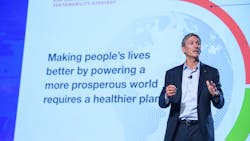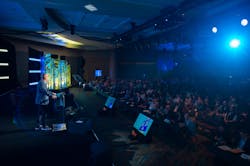Cummins, Freightliner partner on hydrogen fuel-cell truck
LONG BEACH, California—Cummins and Freightliner are collaborating on a hydrogen fuel-cell truck for the North American market. The need for more zero-emission development to help combat climate change was part of keynote addresses by leaders of both companies at the Advanced Clean Transportation (ACT) Expo this week.
Cummins CEO Tom Linebarger used his half-hour on the main stage here to talk about the trucking industry’s responsibility to create a cleaner future. “We think we deliver goods to market and empower things,” he said. “We do things that are essential to the economy, and we are proud of it. We also think, though, that we need to help with prosperity that has to do with making sure we don’t consume and destroy the planet that we live on.
“And frankly speaking, commercial industrial applications are measurable parts of climate change. Cummins engines alone are a measurable part of carbon in the atmosphere. So, to say that we have a role to play would be an understatement.”
See also: How does hydrogen fuel-cell technology work?
Linebarger said he had been searching for some time to find a truck maker with which to partner Cummins’ fuel-cell technology. “Freightliner has an amazing electric chassis that we’re going to put the fuel cell in,” he said. “Fuel cells are great, but you still need an electric drive system that works well, so I’m really excited about that.”
The zero-emission partnership will upfit a Freightliner Cascadia with a fourth-generation Cummins hydrogen fuel-cell powertrain. After the equipment is tested and verified, select customers could get the first units in 2024.
Cummins also is working with Air Products to develop the fuel-cell technology for its fleet, which transports hydrogen. After the testing and development phases, the fleet wants to convert 2,000 trucks to hydrogen fuel cells. The two companies also are working to increase hydrogen fueling infrastructure, they announced last year.
“We have many customers asking for fuel-cell vehicles,” Amy Adams, Cummins VP of fuel cell and hydrogen technologies, told FleetOwner. She said it is essential to get these upfitted fuel-cell tractors on the road to see how they impact fleet operations. “Ultimately, you have to be able to scale up and get to deployment for costs to come down.”
“Change in our industry is far from new—but the pace and nature of that change has certainly picked up—and it has to,” David Carson, Daimler Truck North America’s SVP of sales and marketing, said during his ACT Expo keynote. “The move to zero-emission technologies is necessary. The effects of climate changes are showing themselves in water shortages from Southern California to South Africa. Record-breaking heat from Death Valley to the Indian subcontinent. And increasing wildfires from Australia to our own home in the Pacific Northwest.”
More than 8,000 people descended upon this coastal Southern California city for this year’s ACT Expo to see what large and small transportation companies are developing for an industry setting itself up for a cleaner future. Cummins unveiled a new 15-liter natural gas engine, a near-zero emission X15N. DTNA’s Freightliner used the ACT Expo to announce it will begin series production of the eCascadia, the OEM’s Class 8 battery-electric truck.
“The single largest hurdle in the way forward is a surrounding support system to refuel those trucks,” Carson said. The U.S. needs a 20% increase in electricity generation to turn the roughly 300 billion truck miles traveled in the U.S. per year into zero-emission miles.
DTNA partnered with NextEra Energy Resources and BlackRock Renewable Power to create a nationwide charging network for battery-electric and hydrogen fuel-cell trucks. They plan to build a network of charging sites on critical freight routes along the East Coast and West Coast and in Texas by 2026.
“Depending on the customer application and energy infrastructure considerations, hydrogen-powered vehicles can absolutely complement battery-powered electric vehicles in accelerating our carbon-neutral journey,” said Rakesh Aneja, VP and chief of eMobility at DTNA.






